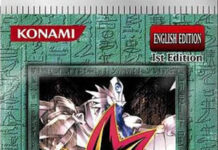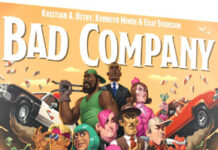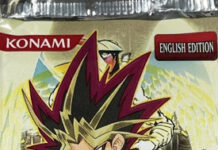In my earlier state of being impressed by Streets of New Capenna‘s innovative visuals and character concepts, I neglected to discuss an important element of the set. It has five crime families, yet almost no law enforcement. There are nine angels in the set who counterbalance the demonic mafia in a general way, but they don’t seem to get directly involved all that much. The flavor text for Angelic Observer, Inspiring Overseer, and Angel of Suffering tells us this. There are rumors that Wizards of the Coast cut law enforcement cards from the set for “extracurricular” reasons, and/or reasons to do with corporate image, which is a choice that a design team can make. But if they did, they should have rethought the entire set, and adjusted the flavor and all the cards. It doesn’t make much sense to have all the crime tropes and none of the law enforcement tropes, because many of the former do not make any sense without the latter.
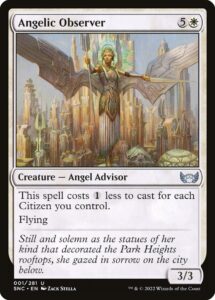
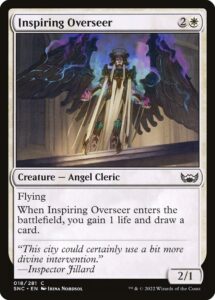
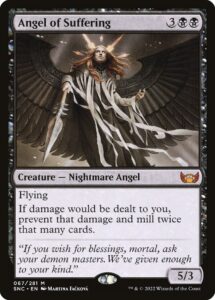
Let’s say, though, that you do end up going with that – five gangs doing things like bootlegging even though nobody seems to be trying to stop them. Let’s say that you then decide later you’re going to do a set about detectives; perhaps because this might allow you to speculate on what Sherlock Holmes would do if he had access to first-level cantrips, and as a bonus give you a way to fight crime unencumbered by all the extracurriculars. This sounds a lot like the other side of the mafia wars expansion, doesn’t it?
So why would you have that set take place on Ravnica instead of New Capenna?
I have heard the rumor that the set was originally going to be a revisit of New Capenna, which would mean that they consciously changed it, which in turn makes the whole thing even more baffling. I find it almost impossible to believe they thought the set’s premise would be a hard sell. Stories about detectives and solving mysteries have been popular at least since Arthur Conan Doyle’s name was in magazine bylines. Sherlock Holmes still gets new editions now. The concepts have been adapted into everything from Murdoch Mysteries to Batman to Scooby-Doo (the last of which is directly referenced in Murders at Karlov Manor. No, really). Cable TV and streaming have sections for both true crime and fictional mystery. Mystery stories hardly seem like a concept that needed to be propped up by Magic’s most popular plane.
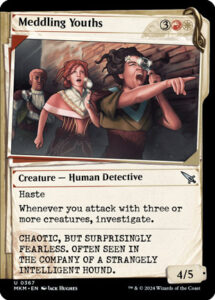
As such, it’s hard to imagine why you would feel a need to pair the theme with a plane that used to induce some players to buy on sight. Perhaps they’d heard the complaints of people who hate Universes Beyond sets, and decided to make a cautious step? Yet they certainly didn’t do that with Outlaws of Thunder Junction, which came out soon after. And there are plenty of fantasy-mystery hybrid stories out there already – compared to a property like Fallout, or the mainline sets Kaladesh and Kamigawa: Neon Dynasty, this concept seems inherently much less risky. It feels like they didn’t trust either New Capenna or some entirely new plane to carry a novel theme.
This is supported by a comment I ran across online, about New Capenna lacking the recognizable characters and setting that Ravnica has. This partly makes sense, because it is much newer. It also partly doesn’t make sense, because you could once have said the same thing about Ravnica, and look at where we are now. People initially found Ravnica to be strange, jarring, and confounding, especially in the first block – the one which only hinted at deeper, darker mysteries under the city and was filled with obscure Slavic references. (Rusalka? Indrik? Drekavac?!)
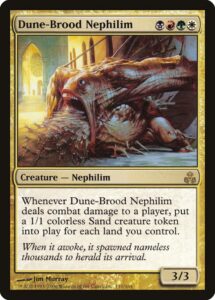
Spending time with the world was what let people get a feel for how its aesthetics affected their experience, for which references they liked and which references they wanted to learn more about, and for the ways in which it enhanced Magic’s overall diversity. But this brings us back to the big glaring problem we’ve had since 2018, doesn’t it? Most sets do not get even a two-set progression nowadays, and the ones that have gotten them are the ones that need them least. The Guilds of Ravnica, Ravnica Allegiance, and War of the Spark trilogy and the Midnight Hunt-Crimson Vow arc added layers to two of the three best-developed planes in the entire Magic mythos. But this was counterbalanced by Streets of New Capenna being a bustling (albeit smaller) city crammed into one set, and March of the Machine trying to tell at least three sets’ worth of story in an expansion smaller than Amonkhet. They wouldn’t even need to go back to doing a formal block structure for every set or as a regular thing – I obviously think there are major advantages to that, but even as things stand now, they claim to have the option to do two or more consecutive sets on the same plane. They just need to make better decisions on when to do this.
With all that said, how does the mystery genre work in Magic? And does a set with this focus enhance Ravnica? The second question is much easier to answer: it makes sense in the ecumenopolis and gives us some insight into a dimension of the city that must surely exist. Cities have advantages, as I like to point out; they also have disadvantages, and one of them is crime. We’ve had hints of Ravnica’s criminal underbelly before, but these mostly involved portraying crimes that fit into the overarching epic struggles of the guilds. Think of the cards that portrayed the Orzhov raising entire neighborhoods of indentured ghosts, or the massed Gruul assaults aimed at returning shopping districts to nature, or the Boros deploying weapons of mass destruction against jaywalkers.
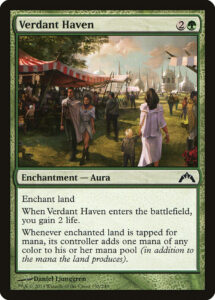
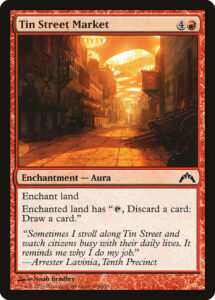
But in both Return to Ravnica and Guilds of Ravnica, we began to get glimpses of the city’s smaller stories and ordinary citizens’ lives, even when they were alongside the aforementioned cataclysms. Publicity articles from the time drew attention to cards like Verdant Haven and Tin Street Market as specific efforts to portray city life as opposed to just city combat. Murders at Karlov Manor leans into this even more – there are no pitched battles or fire raining from the sky, and even the plot that gives the set its name is individual in scale, targeting one prominent figure at a time.
But this, of course, complicates our first question, because Magic has never entirely shaken the shadow of loud, momentous eldritch duels that was laid on it all the way back in the Alpha rulebook. My Fourth Edition booklet has been falling apart for years, but the part about “powerful wizards battling for control of a sphere of Dominia [the Multiverse]” is more or less intact. Even then, they knew this approach had its own issues – there’s a reason that art and flavor text has always portrayed things like citizens’ militias, beautiful landscapes, and humor. There’s a reason why the stories focused on planeswalkers’ personal relationships and foibles, even in the era when they were immortal. The Mending was their first attempt to shift the focus to those personal stories; the Great Desparking that followed March of the Machine is an even bigger one, which I hope is because they’ve finally read some fan articles about apocalypse fatigue.
So in terms of story, Murders at Karlov Manor is a step in a consistent direction – we’ll come back to this with Bloomburrow, and with rumors I’ve heard about its prerelease attendance. It’s a step that I have argued is a good one, as far back as when I went to the point of debating people on Wizards of the Coast’s message boards who were threatening to quit if they didn’t reverse the Mending. But just like Lost Caverns of Ixalan, Karlov Manor is held back by some of the current problems of Magic flavor – the most obvious, once again, being the fact that it’s jammed into one set. Suppose we had a murder mystery that took place across two or even three sets. You wouldn’t then run into the problem of knowing there’s a crime to solve, but opening a set booster and happening to find the card that reveals the culprit before you pull the one that sets up the crime. If you were Wizards of the Coast, you could have a promotion that ran across the two or three sets, where people could submit their guesses for who did it and an explanation referring to cards from the set/s. This is barely a step beyond the way they incorporated actual puzzles into pre-releases and other events, not to mention the Ravnica Clue Edition. While not everyone was interested in these, they added a welcome dimension to a game that has a detrimental tendency to become polarized around one “default” way to play (tournaments for about twenty years, and more recently Commander).
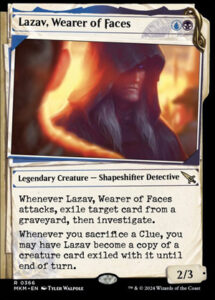
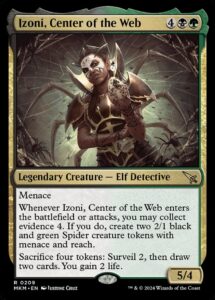
I also have an issue with some of the well-known characters who got new cards where they suddenly have the Detective creature type. It makes perfect sense for Lavinia. Agrus Kos, of the Boros, was a detective to begin with, so it makes sense that some of his guildmates are too. But Lazav and Izoni strike me as being more on the supply side of crime, as Futurama once put it. One of Ravnica’s greatest strengths is that its Plane of Hats elements are weaker than many properties; it could be “the one with the guilds”, but so many worlds have factional conflicts that that doesn’t hurt as much, and it could be “the one with the ecumenopolis”, but we know that cities are diverse and this doesn’t really hurt either. Making all the pre-existing characters be detectives because the set is a murder mystery feels lazy, and it arguably makes a Plane of Hats expansion for a place that was never a Plane of Hats.
And that, yet again, tempts us to think about things other than the cards. Is this really the best way to design a murder mystery set, or is this the fastest way to do it in the context of Magic’s whirlwind release schedule? I fear it may be the latter, and this is an elementary flaw. You don’t want to take players out of the setting, and usually you have to go a long way to do it. People will forgive or overlook the most surprising things in fiction. They generally want to play along. They don’t – I don’t – actually want to talk more about how the set was made than about the set itself. It is disturbing to me how easily Murders at Karlov Manor got people to stop playing along.

